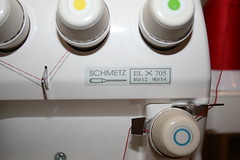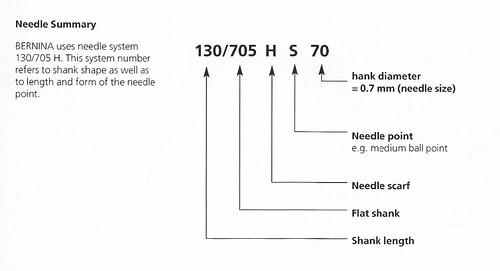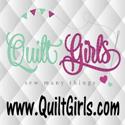What kind of needle do I need?
When you’re starting to sew, there is so much to learn! The machine’s needle seems like it should be such a simple thing, yet all the choices can be overwhelming.
What’s your machine’s needle system?
First, start by looking at your machine. It may tell you exactly what it needs right on it. My coverstitcher has a label right on the front:

My serger hides the information behind the door where the looper threads run:

For my sewing machine, I had to go to the manual.

It uses a 130/705H needle system. This is the most common needle system for household machines. These are also identified as 15×1:HAx1 needles. The S and the 70 in this example mean it is a Sharp point needle in size 70, or 70/10. (Don’t worry, we’ll get to that in a minute.)
All three of these machines work happily with the Organ needles from CTSUSA.com. The sewing machine and serger both want 130/705H or 15×1/HAx1 household machine needles. The coverstitcher uses a different type, the slightly more expensive ELx705. And, even though it says “Schmetz” on the machine’s label, I’ve never had any trouble with the less expensive Organ needles.
70/10? 80/12? 90/14? What are all these numbers?
Machine needle size numbers indicate the needle’s width. Basically, the thicker the needle, the bigger the number. As a general rule, the lighter weight fabrics use smaller needles and heavyweight fabrics use larger needles. Why two numbers? The numbering comes from the combining of two size systems. For the most common needles, European metric needle sizes number needles from 60 to 120. As shown in the image above, a size 70 needle indicates a shank diameter of 0.7mm. The American system numbered the same needles from 8 to 16. The American system reflects size in that a bigger number is a wider diameter, but the number does not correlate to a measurement like the metric system does.
What you sew determines what size needle to use. For example, I use an 80/12 or 75/11 sharp when sewing together two cotton woven fabrics to make quilt squares. For t-shirts and leggings, I use an 80/12 ball point. For fleece, I’ve found a 90/14 ball point seems to give me better results than an 80/12. When sewing twill for a bag or pants, I use a 90/14 sharp. Heavier fabrics, bigger numbers.
Ball point? Sharp? Universal?
A ball point needle is used on knits or very loosely woven fabrics. The ball point will push aside the fibers of the knit rather than cutting through them. A sharp needle used on knit fabric will result in holes in the material.
A sharp needle is used on woven fabrics. Since the fibers are more tightly woven together than in a knit material, they do not pull apart and make holes when the sharp needle pierces them. Using a ball point needle on a woven fabric will tear through and damage the fabric.
A universal needle is similar to a sharp needle, but has a slightly rounded tip.
There are many other types of needles, but for most sewing, having some ball point and sharp needles will get you off to a good start.
Happy Sewing!
This post contains affiliate links, but we’d recommend CTSUSA.com even without the affiliation because their needles are a great bargain!












